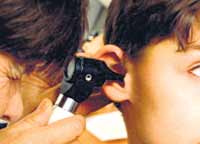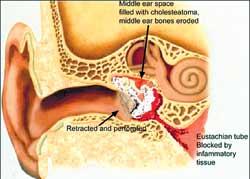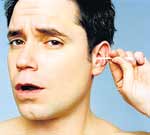| Earful of
problems?
By Smriti Daniel
 There
are many different types of ear problems and there are
also a corresponding number of root causes. Some are
serious, while others are not; and since it may be difficult
to tell, it always pays to have a doctor take a look,
says Dr. Devanand Jha, a consultant ENT specialist.
If left without treatment, it could lead to serious
complications such as irreversible loss of hearing. There
are many different types of ear problems and there are
also a corresponding number of root causes. Some are
serious, while others are not; and since it may be difficult
to tell, it always pays to have a doctor take a look,
says Dr. Devanand Jha, a consultant ENT specialist.
If left without treatment, it could lead to serious
complications such as irreversible loss of hearing.
What to look out for
"One of the indicators of a serious
infection is scanty, foul smelling discharge,"
reveals Dr. Jha, adding that such discharge usually
never comes out onto the pillow. Pain, dizziness, irritation,
itching, soreness, or lumps, all accompanied by fever
may also appear and require attention. Symptoms of impaired
hearing, however slight, should not be ignored.
While many ear infections are easily
dealt with, Dr. Jha cautions that such problems are
not always driven away by a simple course of ear drops.
Certain symptoms may be caused by cancer of some kind
or may be linked to serious illnesses that require immediate
treatment.
Otitis Externa (OE)
This is one of the more common infections
Dr. Jha says. "It is an infection of the ear canal,"
he says, explaining that because the canal is dark and
warm, bacteria and fungus can flourish. Our hot, humid
weather also adds to the condition. Several other factors
may increase your risk of getting OE such as over vigorous
removal of ear wax, or damage to the tender skin inside.
Itching and pain accompany the infection.
You might find an increase in those sensations while
chewing food. In addition, your ears might feel all
plugged up and it might be difficult to hear clearly.
A build-up of fluid and pus may occur in which case
you will need to have your doctor examine your ear canal
and treat you, explains Dr. Jha. The doctor will also
inspect your ear drum to rule out any other problem,
once the swelling in the ear has settled down.
Otitis Media
"Otitis media refers to inflammation
in the middle ear area," says Dr. Jha, adding that
the infection often follows a viral upper respiratory
tract illness, such as a cold or sore throat. While
there are different forms of otitis media, acute otitis
media is most common. Such cases are marked by the presence
of fluid, typically pus, in the middle ear with symptoms
of pain, redness of the eardrum, and possible fever.
Many children will have several bouts of otitis media
before they are seven years old. Symptoms include crying,
ear pulling, mild fever and irritability.
Glue Ear
Glue ear is a type of chronic otitis
media. "This is a common problem,” says Dr.
Jha. He explains that over a long period of time as
fluids build up behind the eardrum, they begin to thicken
and get sticky. The fluid dampens the vibrations of
the eardrum and bones (ossicles) made by the sound waves.
The cochlea in turn receives these dampened vibrations.
The result? Hearing loss. Glue ear usually occurs in
young children, says Dr. Jha, due to the fact that their
Eustachian tubes are much smaller and more horizontal
than those of adults.
Cholesteatoma
 |
| Cholesteatoma |
"This is a bone destroying disease,"
says Dr. Jha, explaining that a cholesteatoma is a slow-growing
mass in the middle ear, that if left unchecked will
slowly erode and destroy anything in its way, beginning
with the three middle ear bones, (also known as the
"hammer", the "anvil" and the "stirrup")
and the bone surrounding the ear next to the brain.
Cholesteatomas may also erode into
the balance and hearing organs of the inner ear. For
this reason, cholesteatomas are best removed as soon
as possible.
Tinnitus
We've all heard that ringing in our
ears. Though, tinnitus is not itself a disease, it can
be an unwelcome symptom resulting from a range of underlying
causes. Someone with the problem may hear anything from
a quiet background noise to one loud enough to drown
out all outside sounds.
Tinnitus can be noise trauma induced,
drug induced (including alcohol!), or due to hearing
problems (both conductive and sensorineural). "Tinnitus
may also be the only symptom of sinister problems such
as a tumour in the brain," says Dr. Jha. He adds,
"Tinnitus patients should get certain investigations
done to rule out serious problems." Unfortunately,
tinnitus doesn't have a direct cure, though once the
cause is ascertained and depending on it, something
could be done.
Ear wax
In a normal ear, wax acts as protection.
If you feel the need to use an ear bud, keep it light
and easy instead of plumbing the depths of your ear,
recommends Dr. Jha. "There are tiny hairs in your
ear that expel the wax," he says. "Let nature
take its course." In cases where a build-up of
wax becomes a problem, wax softening drops may be used
and sometimes the ears may also need to be syringed
clean by the doctor.
Children and ear infections
 |
| If you feel the need to use an
ear bud, keep it light and easy instead of plumbing
the depths of your ear |
It is unfortunate that those who fall
victim most easily to these infections, may also be
those most unable to express their discomfort. For this
reason, parents should keep an eye out for changes in
behaviour patterns, such as sudden inattention in school,
lack of response to instructions, apparent disobedience,
or wanting the television very loud.
Also if a child is too young to identify
an earache, he or she might just be more cranky and
reluctant to do things that affect the ear such as chewing
and swallowing.
|
